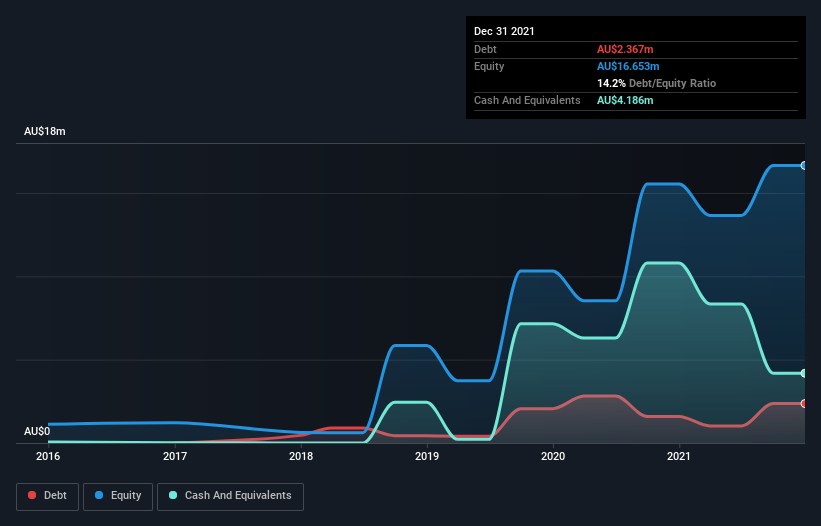Health Check: How Prudently Does ImExHS (ASX:IME) Use Debt?
The external fund manager backed by Berkshire Hathaway's Charlie Munger, Li Lu, makes no bones about it when he says 'The biggest investment risk is not the volatility of prices, but whether you will suffer a permanent loss of capital.' So it seems the smart money knows that debt - which is usually involved in bankruptcies - is a very important factor, when you assess how risky a company is. We can see that ImExHS Limited (ASX:IME) does use debt in its business. But the more important question is: how much risk is that debt creating?
What Risk Does Debt Bring?
Generally speaking, debt only becomes a real problem when a company can't easily pay it off, either by raising capital or with its own cash flow. Part and parcel of capitalism is the process of 'creative destruction' where failed businesses are mercilessly liquidated by their bankers. However, a more frequent (but still costly) occurrence is where a company must issue shares at bargain-basement prices, permanently diluting shareholders, just to shore up its balance sheet. Of course, the upside of debt is that it often represents cheap capital, especially when it replaces dilution in a company with the ability to reinvest at high rates of return. The first step when considering a company's debt levels is to consider its cash and debt together.
See our latest analysis for ImExHS
What Is ImExHS's Debt?
The image below, which you can click on for greater detail, shows that at December 2021 ImExHS had debt of AU$2.37m, up from AU$1.60m in one year. However, its balance sheet shows it holds AU$4.19m in cash, so it actually has AU$1.82m net cash.
How Healthy Is ImExHS' Balance Sheet?
The latest balance sheet data shows that ImExHS had liabilities of AU$7.10m due within a year, and liabilities of AU$2.01m falling due after that. On the other hand, it had cash of AU$4.19m and AU$7.01m worth of receivables due within a year. So it actually has AU$2.09m more liquid assets than total liabilities.
This short term liquidity is a sign that ImExHS could probably pay off its debt with ease, as its balance sheet is far from stretched. Succinctly put, ImExHS boasts net cash, so it's fair to say it does not have a heavy debt load! There's no doubt that we learn most about debt from the balance sheet. But ultimately the future profitability of the business will decide if ImExHS can strengthen its balance sheet over time. So if you're focused on the future you can check out this free report showing analyst profit forecasts.
In the last year ImExHS wasn't profitable at an EBIT level, but managed to grow its revenue by 24%, to AU$14m. With any luck the company will be able to grow its way to profitability.
So How Risky Is ImExHS?
We have no doubt that loss making companies are, in general, riskier than profitable ones. And in the last year ImExHS had an earnings before interest and tax (EBIT) loss, truth be told. And over the same period it saw negative free cash outflow of AU$5.5m and booked a AU$4.7m accounting loss. But at least it has AU$1.82m on the balance sheet to spend on growth, near-term. ImExHS's revenue growth shone bright over the last year, so it may well be in a position to turn a profit in due course. By investing before those profits, shareholders take on more risk in the hope of bigger rewards. When analysing debt levels, the balance sheet is the obvious place to start. However, not all investment risk resides within the balance sheet - far from it. Be aware that ImExHS is showing 5 warning signs in our investment analysis , and 2 of those are a bit unpleasant...
At the end of the day, it's often better to focus on companies that are free from net debt. You can access our special list of such companies (all with a track record of profit growth). It's free.
Have feedback on this article? Concerned about the content? Get in touch with us directly. Alternatively, email editorial-team (at) simplywallst.com.
This article by Simply Wall St is general in nature. We provide commentary based on historical data and analyst forecasts only using an unbiased methodology and our articles are not intended to be financial advice. It does not constitute a recommendation to buy or sell any stock, and does not take account of your objectives, or your financial situation. We aim to bring you long-term focused analysis driven by fundamental data. Note that our analysis may not factor in the latest price-sensitive company announcements or qualitative material. Simply Wall St has no position in any stocks mentioned.

